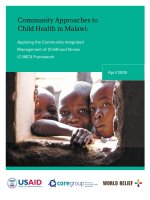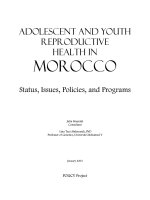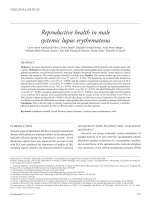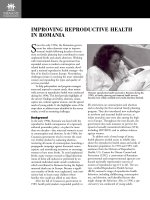Background for Community-Level Work on Positive Reproductive Health in Adolescence: Reviewing the Literature on Contributing Factors pot
Bạn đang xem bản rút gọn của tài liệu. Xem và tải ngay bản đầy đủ của tài liệu tại đây (94.69 KB, 6 trang )
1
Background for Community-Level Work on Positive Reproductive Health in Adolescence:
Reviewing the Literature on Contributing Factors
EXECUTIVE SUMMARY
By: Jennifer Manlove
With high rates of unintended adolescent pregnancy, childbearing, and sexually transmitted
infections (STIs) in the United States, it is important to understand the range of factors that are
associated with positive reproductive health behaviors. By far, the most straightforward way to
maintain positive reproductive health behaviors (or to avoid early pregnancy, childbearing or
STIs) is to abstain from sexual intercourse. However, as adolescents age, their likelihood of
becoming sexually experienced increases. Thus, it is also important to understand factors
associated with the frequency of sexual activity, the number of sexual partners, and contraceptive
use for STI or pregnancy prevention. This chapter assesses factors associated with multiple
aspects of positive reproductive health, including delaying sexual initiation, reducing the
frequency of sexual activity and the number of sexual partners, using condoms for disease
prevention or contraception for pregnancy prevention, delaying pregnancy and childbearing, and
avoiding an STI.
This chapter proceeds from an ecological framework, which recognizes that multiple aspects of
an adolescent's life may affect their reproductive health experiences, including a teen's family
environment, their individual attitudes and behaviors, and peer attitudes and behaviors. In
addition, the characteristics of a teen's community, including school context, neighborhood
environment, and broader policies may affect reproductive health behaviors. Finally, programs
targeted to improving adolescent development, in general, and to reducing risky sexual
behaviors, in particular, show a range of activities that may help reduce unintended pregnancy,
childbearing and the incidence of STIs.
The majority of studies addressed in this chapter reflect research findings that provide "best bets"
for preventing sexual risk-taking behaviors. These derive from longitudinal, multivariate
analyses of reproductive health topics. In addition, a synthesis of programs that have had
rigorous experimental designs help provide information on "what works" and what doesn't work
within the program field. The synthesis of best bets from research findings, combined from
“what works” from those programs that have been evaluated, may help provide a context for the
types of programs necessary to help bring levels of adolescent pregnancy, childbearing, and STIs
in the United States to levels that are at least comparable to other industrialized countries.
Despite recent declines in the U.S. teen pregnancy rate and teen birth rate, there are multiple
reasons to maintain a focus on this social issue. This review provides promising approaches to
inform research and programs to continue reductions in adolescent risk-taking behaviors.
Individual characteristics, family factors, peers, partners, school context, neighborhood context,
and policy and programs all have a potential influence on reproductive health behaviors.
2
Individual Factors
Multiple individual characteristics are associated with positive reproductive health behaviors.
Demographic characteristics, including gender, race/ethnicity, and age are all important, with
males more likely than females to initiate sexual intercourse at an early age and to exhibit greater
levels of sexual activity; racial and ethnic minorities more likely to engage in behaviors related
to early pregnancy, childbearing and STIs, and older teens more likely be sexually experienced
but also more likely to use contraception (Abma & Sonenstein, 2001; Miller, Norton et al., 1997;
Raine et al., 1999; Santelli et al., 2000). Pubertal development and age at menarche are
associated with the likelihood of being sexually experienced, and teens who appear older or more
physically developed are more likely to be involved in sexual activity (Miller, Norton et al.,
1997; Resnick et al., 1997).
Individual engagement and performance in school (Afxentiou and Hawley, 1997; Manlove,
1998; Thornberry et al., 1997), religious activities (Halpern et al., 2000; Lammers et al., 2000;
Mott et al., 1996), and sports (among females) (Miller, Sabo et al., 1998; Sabo et al., 1998) are
all associated with more positive reproductive health behaviors, indicating that involving teens in
outside activities may help them avoid other risk-taking behaviors. In contrast, teens who are
already involved in other risk-taking behaviors such as alcohol and drug use are more likely to
engage in risky sexual behaviors (Kowaleski-Jones & Mott, 1998; National Center on Addition
and Substance Abuse, 1999). Adolescents with a history of sexual abuse were more likely to be
sexually active at an early age and to have reduced contraceptive use (Raj, Silverman, & Amaro,
2000; Stock et al., 1997); however, longitudinal studies are needed to understand the relative
sequencing of abuse and sexual activity. Adolescents with a greater knowledge of reproductive
health issues are more likely to use contraception (Manning et al., 2000; Mauldon & Luker,
1996), and virginity pledges appear to protect against early sexual activity among some
populations (Bearman & Brückner, 2001). In addition, teens who are highly motivated and
confident that they will delay sexual initiation are more likely to do so (Carvajal et al., 1999).
Teens who perceive that their peers are sexually active are more likely to initiate sex themselves
(Miller, Norton, et al., 1997), and those who feel that sexual experience is associated with greater
respect are also more likely to have sexual intercourse (Kinsman et al., 1998).
Family Background
Multiple family characteristics are associated with positive reproductive behaviors. Teens who
grow up in intact families with two biological parents, and adolescents whose families have
higher socioeconomic status (including higher education and income) are more likely to have
more positive reproductive behaviors (Miller, 1998). Further, teens whose parents had children
at an early age or who have siblings who have had an early pregnancy are more likely to have an
early age of sexual initiation and a greater likelihood of a teenage pregnancy or birth (East
1996a, 1996b; Widmer, 1997).
The quality of parent-adolescent relationships is also associated with sexual decision-making.
Adolescents who feel like they have a high-quality relationship with their parents, who
3
communicate regularly with their parents are more likely to initiate sex at a later age and exhibit
fewer sexual risk-taking behaviors (Miller, 1998). Parents who discuss issues of sexuality and
contraceptive use and who communicate strong disapproval of sexual activity are more likely to
have children with more positive reproductive health outcomes (Miller, Levin, Whitaker, & Xu,
1998; Romer et al. 1999). Adolescent children whose parents are involved in their schooling
exhibit fewer risk-taking behaviors (Manlove, 1998). In addition, parents who closely monitor
their adolescents' activities have children who are less sexually active (Miller, 1998).
Peers
Adolescent peer attitudes and behaviors are associated with reproductive health decisions. Teens
with sexually active friends are more likely to have had sexual intercourse themselves (Miller,
Norton, et al., 1997). In addition, teens who believe
that their friends are having sex are more
likely to initiate sexual intercourse at an earlier age (Kinsman et al., 1998). Peer attitudes
towards sex and contraception influence adolescent behaviors (Whitaker & Miller, 2000).
Alternatively, teens who report high achieving peers with strong educational aspirations and
peers who avoid other risk-taking behaviors are less likely themselves to have sex at an early age
and are more likely to avoid an early pregnancy (Bearman & Brückner, 1999).
Partners
The relationship that adolescents have with their sexual partners, as well as the characteristics of
their partners, are associated with their likelihood of using contraception and risk of pregnancy
and STI. Not surprisingly, adolescents who have dated or who report that they have been in a
romantic relationship are more likely to engage in sexual intercourse than those who have not
(Blum, Beuhring, & Rinehart, 2000), and married teens report a greater incidence of pregnancy
(Darroch, Landry, & Oslak, 1999b). Adolescents who participate in risky behaviors such as drug
and alcohol use are more likely to have multiple sexual partners, which puts them at a greater
risk of pregnancy and STIs (Santelli, et al., 1998). Some studies show that teens in casual
relationships were less likely to use a contraceptive method, at least at first sexual intercourse
(Manning et al., 2000), while others suggest that teens may be more likely to use a contraceptive
method with more casual partners (Forste & Morgan, 1998). Teens who discuss sexual risk with
their partners are more likely to use a contraceptive method (Whitaker et al., 1999). In addition,
teens with nonvoluntary sexual experiences and teens with much older sexual partners appear to
be at-risk of early intercourse, multiple sexual partners, failure to use contraception, and a greater
risk of pregnancy (Abma, Driscoll, & Moore, 1998; Darroch, et al., 1999a; Stock et al., 1997).
Teen females who have sex with a partner of the same religion are less likely to become pregnant
outside of marriage
School Context
The school system represents one institution that most adolescents are involved in, and studies
show that the types of schools that teens attend, their perceptions of safety in school, and
characteristics of the school population are all associated with reproductive health behaviors.
Attending a private or Catholic school is associated with delayed sexual activity and a reduced
4
risk of pregnancy and childbearing (Manlove, 1998; Resnick et al., 1997). Attending schools
with fewer disadvantaged teens and attending safer schools with lower levels of crime and
vandalism are also associated with more positive reproductive health behaviors (Manlove, 1998;
Moore et al., 1998). Attending sex education programs in schools appears to be associated with
improved knowledge of contraception and in some studies has shown an association with
delayed sexual activity and improved contraceptive use among some populations (Kirby et al.,
1994).
Neighborhood and Community
The neighborhoods and communities that adolescents live in may also influence their
reproductive health behaviors. Numerous studies show that adolescents living in disadvantaged
communities with high poverty rates and low levels of socioeconomic status have a greater risk
of early sexual initiation and a greater risk of adolescent pregnancy and childbearing (Brewster,
Billy, & Grady, 1993; Hogan & Kitagawa, 1985; Sucoff & Upchurch, 1998). Alternately, living
in a community with higher socioeconomic status is associated with a reduced risk of risky
sexual activity. Racial/ethnic composition also influences outcomes, although this may be
through the presence or absence of available sexual partners (Brewster, et al., 1993; Billy,
Brewster, & Grady, 1994). In addition, living in a community with higher crime rates is also
associated with riskier sexual behaviors (Billy et al., 1994).
Policies and Programs
There have been multiple studies of programs focused on positive youth outcomes in general and
on reproductive health behaviors in particular. Many programs show promising results, although
there have been few rigorous experimental replication studies. See the “what works” table at the
end of the chapter for details on specific programs.
Addressing early educational experiences appears to be associated with reduced pregnancy and
childbearing years later, as is evidenced by two preschool / child care programs that focused on
strengthening educational outcomes among disadvantaged children (Horacek et al., 1987;
Schweinhart, Barnes & Weikart, 1993).
Two youth development programs that combine community volunteer service with classroom
discussions have an impact on reduced sexual activity and pregnancy as well as on other positive
educational outcomes (Allen et al., 1997; Kirby, 2001).
Adolescent programs that combine a focus on youth development (including activities such as
educational mentoring, employment, sports, and performing arts) with a section on sexuality
education can have a strong impact on reproductive health outcomes; however, current programs
in this area are intensive and long-term and appear to work better for some populations than
others (e.g., influence sexual and pregnancy outcomes among females but not males in one
study) (McBride & Gienapp, 2000; Philliber et al., 2001). However, vocational education
programs that have been evaluated have not shown an impact on reproductive health outcomes
5
(Cave et al., 1993; Schochet, Burghardt & Glazerman, 2000; Walker & Villela-Velez, 1992) with
one program showing reduced pregnancy rates among black females only (Jastrab et al., 1997).
Several sexuality education programs have been evaluated, and many include a combination of
abstinence messages for sexually inexperienced teens and messages about contraceptive use for
sexually experienced teens. Slightly more than half of these programs show some positive
impacts on reproductive health outcomes for at least some populations (Aarons et al., 2000;
Eisen, Zellman & McAlister, 1990; Kirby, 2001; Thomas et al., 1992). Several HIV education
programs were evaluated and slightly more than half of them show some positive impacts on
sexual activity and contraceptive use for at least some populations (St. Lawrence et al., 1995;
Jemmott III, Jemmott & Fong, 1992, 1998). Only one abstinence-only education program has
been evaluated with a rigorous experimental design, and it did not show a significant impact on
reproductive health outcomes (Kirby et al., 1997). However, current large-scale evaluations of
abstinence-only programs should provide more information on the effectiveness of these
programs in the future. Those sexuality education and HIV education programs that did show
positive impacts on reproductive health outcomes tend to have multiple components, are based
on theoretical approaches, deliver clear messages, engage participants in activities, and provide
appropriate training for teachers or peer leaders (Kirby, 2001). Only one experimental program
has evaluated a project to improve parent-child communication about sexuality, and this program
did not show an impact on outcomes (Miller et al., 1993).
Several clinic-based programs have been evaluated with experimental designs and three (out of
five) of them showed some positive impacts on reproductive health outcomes (Danielson et al.,
1990; DeLameter et al., 2000; Orr et al., 1996). Those programs that showed positive impacts
included one-on-one counseling and delivered a clear message about appropriate reproductive
health behaviors (Kirby, 2001).
School-based health centers and condom-availability programs have not had experimental
evaluations, and thus cannot be included in the “what works” section of our final table.
Available studies suggest that these programs show mixed associations with reproductive health
outcomes (Kirby, 2001). Community-wide initiatives to influence behavior in a large area are
also quasi-experimental and have not had successful results, possibly due to their ambitious goals
of affecting community-wide behaviors (Kirby, 2001). No concrete conclusions can be made
from any of these studies, however, because they do not include experimental designs.
Several programs have been initiated to reduce subsequent fertility to teenage mothers.
Although research studies suggest that welfare benefit levels may influence adolescent fertility
outcomes (Hoffman & Foster, 1999; Horvath-Rose & Peters, 2001; Hudson & Moffitt, 1997;
Manlove et al., 1999; Rosenzweig, 1999), welfare demonstration programs have not shown
significant impacts on reducing subsequent fertility to teen mothers (Kisker, Rangarajan &
Boller, 1998; Quint et al., 1997). However, some nurse home visiting programs with strong
evaluations have shown an impact of an intensive series of visitations on reducing subsequent
fertility (Olds et al., 1999).
6
Conclusions
In sum, a large and high-quality literature exists that identifies the antecedents of adolescent
sexual and fertility behavior and thereby suggests avenues for interventions. Far fewer high-
quality experimental evaluations of intervention programs have been conducted. These studies
indicate that interventions addressing the antecedents of adolescent pregnancy and STIs can be
effective, with early childhood, youth development, community volunteer learning programs,
and nurse home visiting approaches appearing as important complements to traditional sexuality
and HIV education programs and clinic service approaches.









